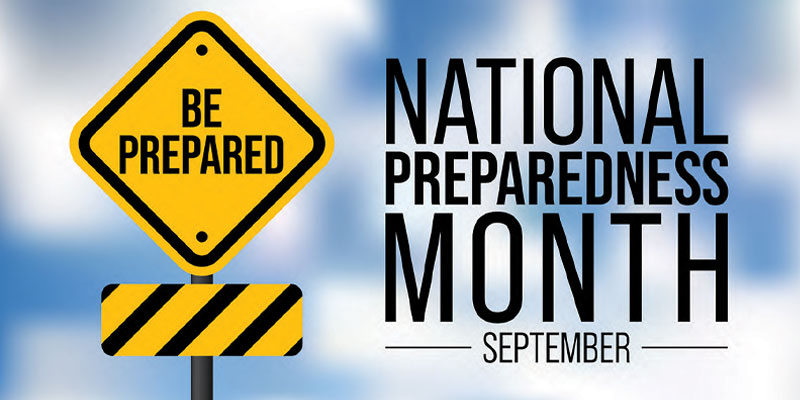
By Courtney Morris
If you’ve lived in Houston long enough, you may equate emergency preparedness with hurricane hustle: the last-minute to-do list check-off as the Gulf sends another storm our way.
This February, an Arctic front reminded us we have more seasons to consider than the active tropics June 1 to Nov. 30. Whether the disaster comes from Mother Nature, emergency preparedness is always in season.
September is National Preparedness Month. Want to get ahead of the next disaster? San Jacinto College Office of Emergency Management Director Ali Shah shares tips to help you get started.
Adopt the mindset
Shah has navigated many disasters during his 22 years in public safety. Lesson learned: It’s always best to have a plan — the earlier, the better.
“The [preparedness] mindset doesn’t have to happen right when a hurricane is coming or when it’s starting to get cold,” he said.
Preparedness begins with asking yourself:
1. How will I learn about emergencies?
2. What are my specific needs?
Will you watch TV or listen to the radio? Do you receive text message alerts? You can also buy a NOAA emergency radio that broadcasts public alerts.
Not tech-savvy or tuned in to media? Ask a trusted neighbor, friend, or family member who gets alerts to call you immediately in an emergency.
Also, do you have specific medical needs, and can you take care of yourself if you stay at home?
“It’s a deeper, more thoughtful discussion for seniors,” Shah said.
Preparedness means you know how to take care of yourself before a disaster happens. Even if you can’t do everything on your own, you know how to direct family, friends, or emergency responders to help you.
Develop the plan
Once you know how you’ll learn about emergencies and what your needs are, it’s time to create the plan.
“Even if you haven’t accomplished everything on the plan, at least you have a roadmap of what to do,” Shah said.
Your plan should include these six steps:
1. Choose your evacuation spot.
If you need to evacuate (and Shah says you should when officials call for an evacuation), where would you go — a family member’s home, statewide shelter, or community center? And how would you get there?
If you’ll need help getting to a shelter or another location or accessing resources in an emergency, call 2-1-1 now to be added to a statewide/local registry. This registry lets emergency responders know who you are, where you live, and what help you need in an emergency.
2. Don’t forget Spot and Fluffy.
If you have pets, plan where you’ll take them. Share details about any pets if you register with 2-1-1. You may not be able to go to your nearest shelter, but pets are allowed in certain shelters. You can evacuate — and take your pets with you!
3. Extend your prescriptions.
Talk to your doctor about getting an extra supply of your medications. Have more on hand than you need in case pharmacies close because of extended power outages.
4. Assemble a “go kit.”
“Gather the things you need to sustain you from where you are to where you’re getting evacuated,” Shah said.
- At minimum, put these items in a backpack or small storage tub:
- 1-2 changes of clothes
- Printed contact information for your doctor, family, and friends
- Printed copies of your driver’s license, Social Security card, and other identification sealed in a heavy-duty Ziploc bag
If you’re checking in at a shelter, you’ll need identifying information. Shah recommends keeping the copies stored securely on a smartphone. But if you prefer carrying printed copies, keep them on you to avoid identity theft.
Finally, slap a sticky note on the kit for last-minute items to add:
- Prescriptions
- Nonperishable snacks/food
- Pet food
- Water bottles
- Phone charger
5. Consider your mental health.
Have a good support system — know whom you can call if you feel overwhelmed. Besides family or friends, you can call 1-800-273-8255 (National Suicide Prevention Lifeline) or text “HOME” to 741741 (National Crisis Text Line).
6. Communicate your plan.
Make this a family activity. Bring everyone together to plan so each person has ownership. Share what steps you’ve taken and where you want to evacuate. Problem-solve together.
Go the extra mile
Life circumstances are always changing, so review your plan often and update. Also, consider learning skills like CPR and first aid.
Finally, Shah recommends visiting these websites:
- Ready.gov: General emergency resources
- Readyharris.org: Resources for residents in and around Harris County
- 211texas.org: State and local emergency resources (call the free 2-1-1 hotline to be added to a registry if you need special resources/evacuation help during disasters)
If you feel overwhelmed about starting, tackle one step today — then another tomorrow. The important thing is to start.
“When you start a plan and your plan matures, you deal with disaster the way you deal with any other hurdle in life,” Shah said. “Knowing you have an answer to the problems you might face during a stressful time can keep a disaster from becoming your disaster.”



